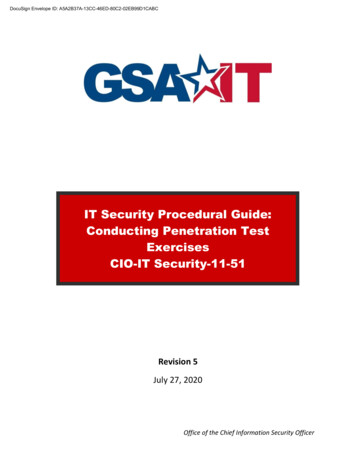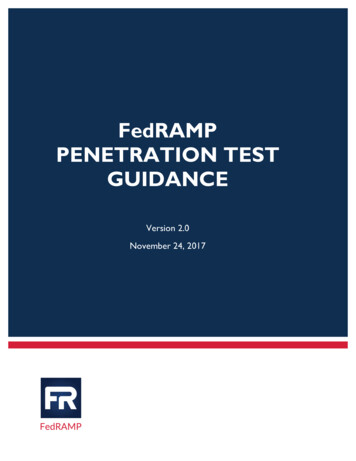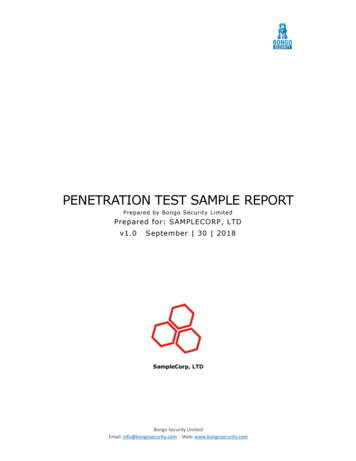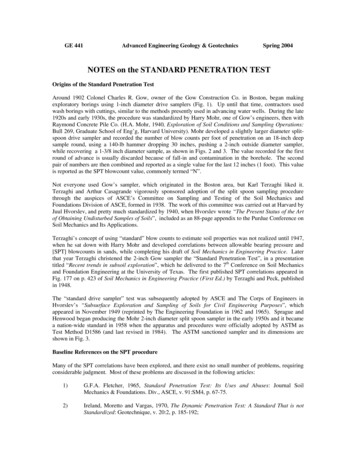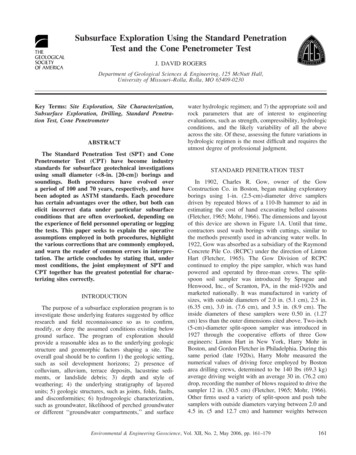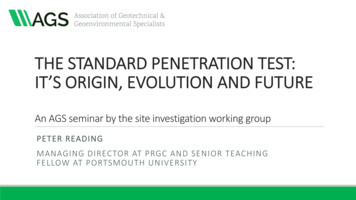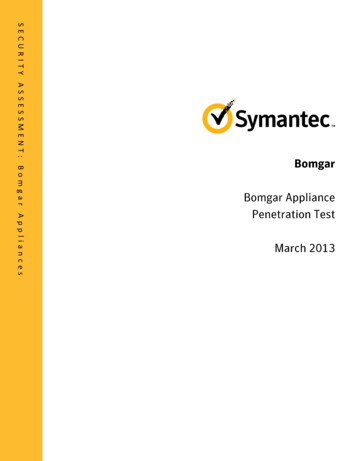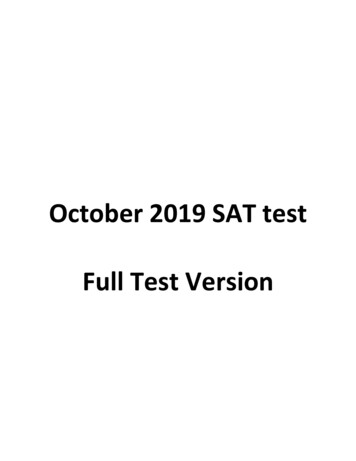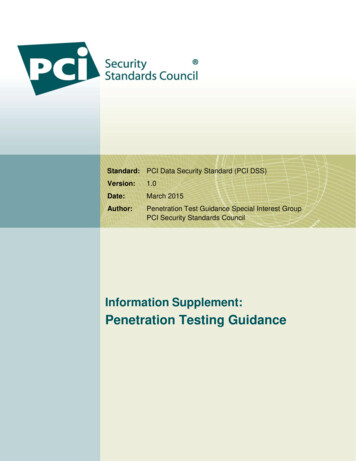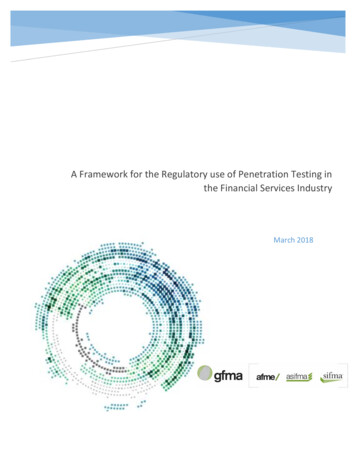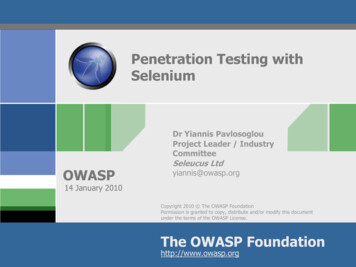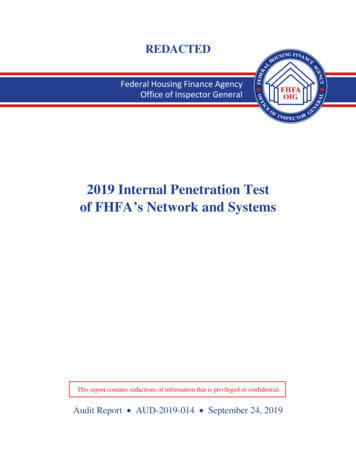
Transcription
REDACTEDFederal Housing Finance AgencyOffice of Inspector General2019 Internal Penetration Testof FHFA’s Network and SystemsThis report contains redactions of information that is privileged or confidential.Audit Report AUD-2019-014 September 24, 2019
Executive SummaryAUD-2019-014September 24,2019The Federal Housing Finance Agency (FHFA or Agency), established by theHousing and Economic Recovery Act of 2008, is responsible for thesupervision, regulation, and housing mission oversight of Fannie Mae, FreddieMac, and the Federal Home Loan Bank System. Within FHFA, the Office ofTechnology and Information Management (OTIM) works with the Agency’soffices to promote the effective and secure use of information and systems.The Federal Information Security Modernization Act of 2014 (FISMA)requires agencies, including FHFA, to develop, document, and implementagency-wide programs to provide information security for the information andinformation systems that support the operations and assets of the agency.FISMA also requires inspectors general to perform annual independentevaluations of their respective agencies’ information security program andpractices. The annual FISMA audit of FHFA, however, does not includepenetration testing of FHFA’s network and systems. In 2018, we performedan external penetration test of FHFA’s network and systems. This year, weperformed an internal penetration test to determine whether FHFA’s securitycontrols were effective to protect its network and systems against internalthreats. For purposes of this audit, we were given the same access a typicalFHFA employee would be given—general user access with no special rightsor privileges.Using the access given to a typical FHFA employee, we determined thatFHFA’s network, systems, and information were not sufficiently protectedagainst insider threats. We found: an FHFA wireless network intended for employees’ personal use ofthe internet improperly allowed non-FHFA-issued devices to accessFHFA’s internal network. Through this wireless network connection,we were able to scan FHFA servers. Our scanning tools identified highseverity and medium severity vulnerabilities related to outdatedandprotocols in FHFA’s systems. sensitive informationWe also demonstrated to FHFA our capability tothis information. some offices in FHFA’s headquarters building were open outside ofbusiness hours with sensitive information left unattended and plainly
visible. We were also able to access sensitive information bylocated in some of those offices.AUD-2019-014September 24,2019 controls did not prevent the use of unapproved programs(known as”).“ default administrator passwords were not changed on.As these control deficiencies were identified during our audit, we broughtthem to the attention of FHFA management who took or began to takeremedial actions to address them. These vulnerabilities, if not remediated,pose risk to FHFA’s network, systems, and information. Continuedmanagement attention and action is required to ensure that FHFA’s securitycontrols protect its network and systems against internal threats.We make six recommendations in this report. In a written managementresponse, FHFA agreed with our recommendations.This report was prepared by Jackie Dang, IT Audit Director; Dan Jensen,Auditor-in-Charge; and Nick Peppers, IT Specialist; with assistance from BobTaylor, Senior Advisor. We appreciate the cooperation of FHFA staff, as wellas the assistance of all those who contributed to the preparation of this report.This report has been distributed to Congress, the Office of Management andBudget, and others, and will be posted on our website, www.fhfaoig.gov, andwww.oversight.gov.Marla A. Freedman, Deputy Inspector General for Audits /s/
TABLE OF CONTENTS .EXECUTIVE SUMMARY .2ABBREVIATIONS .6BACKGROUND .7Standards for Information Security Controls and Testing .7FHFA’s Network and Systems .8FACTS AND ANALYSIS.9Internal Vulnerability Testing Found that an FHFA Wireless Network Intended Onlyfor Personal Use by Employees Improperly Allowed Non-FHFA-Issued Devices toAccess FHFA’s Internal Network .9Our Scanning Tools Identified High Severity and Medium SeverityVulnerabilities in FHFA’s Systems, But We Were Unable to Exploit Them .10Internal Penetration Testing Found that Sensitive Information.11Physical Security Controls Within FHFA’s Headquarters Building Did Not PreventAccess to the Offices and Information ofand Other FHFAEmployees.12Sensitive Information Unattended and Plainly Visible.12Unattended Access to Desktop Computers.12Controls Did Not Prevent the Use of Unauthorized Programs.13Had Default Administrator Passwords .14FINDINGS.14Allowed Non-FHFA-Issued Devices to Access FHFA’s InternalNetwork .14Outdated Security Protocols Were in Use .15Sensitive Information onWas Available to.15Some Employees Did Not Adhere to Physical Security Requirements Designed toProtect Sensitive Information .15Unauthorized Programs Could Beon FHFA Computers .16Default Administrator Passwords Were in Use onOIG AUD-2019-014 September 24, 2019.164
CONCLUSION.16RECOMMENDATIONS.17FHFA COMMENTS AND OIG RESPONSE.17OBJECTIVE, SCOPE, AND METHODOLOGY .18APPENDIX: FHFA MANAGEMENT RESPONSE .21ADDITIONAL INFORMATION AND COPIES .24OIG AUD-2019-014 September 24, 20195
ABBREVIATIONS .CVSSCommon Vulnerability Scoring SystemFHFAFederal Housing Finance AgencyFISMAFederal Information Security Modernization Act of 2014ITInformation TechnologyNISTNational Institute of Standards and TechnologyNIST SP 800-53NIST Special Publication, Revision 4, Security and Privacy Controls forFederal Information Systems and OrganizationsOTIMOffice of Technology and Information ManagementPIIPersonally Identifiable InformationPIVPersonal Identity VerificationSPSpecial PublicationOIG AUD-2019-014 September 24, 20196
BACKGROUND.Standards for Information Security Controls and TestingFISMA requires agencies, including FHFA, to develop, document, and implement agencywide programs to provide information security for the information and information systemsthat support the operations and assets of the agency. In addition, FISMA requires agencies toimplement periodic testing and evaluation of the effectiveness of security policies,procedures, and practices. Pursuant to FISMA, the National Institute of Standards andTechnology (NIST) is responsible for developing information security standards andguidelines, including minimum requirements for Federal information systems.For FHFA, the FISMA-required annual independent evaluations are performed by anindependent external auditor under contract with our office. For fiscal year 2018, 1 the auditfound that FHFA complied with FISMA and related Office of Management and Budgetguidance, and that sampled security controls selected from NIST Special Publication (SP)800-53, Revision 4, Security and Privacy Controls for Federal Information Systems andOrganizations (NIST SP 800-53), demonstrated operating effectiveness. 2NIST SP 800-115, Technical Guide to Information Security Testing and Assessment, providesguidelines for designing, implementing, and maintaining technical information relating tosecurity testing. It describes several techniques for identifying targets and analyzing them forpotential vulnerabilities, such as network discovery, network port and service identification,vulnerability scanning, and wireless scanning. According to NIST, testing for vulnerabilitiesalso includes non-technical methods such as physical security testing. Physical securitytesting includes attempts to circumvent locks, badge readers, and other physical securitycontrols. By circumventing physical controls, testers have additional methods available to3access networks, equipment, and sensitive information1As of the date of this report, our FISMA audit of FHFA for fiscal year 2019 is under way.2NIST SP 800-53 provides a catalog of security and privacy controls for federal information systems andorganizations and a process for selecting controls to protect organizational operations (including mission,functions, image, and reputation), organizational assets, individuals, other organizations, and the Nation from adiverse set of threats, including hostile cyberattacks, natural disasters, structural failures, and human errors.3OIG AUD-2019-014 September 24, 20197
FHFA’s Network and SystemsFHFA’s network and systems process and host data and information such as financial reports,data from the Enterprises, examinations and analyses of the regulated entities, and personallyidentifiable information (PII) 4 of employees. FISMA requires FHFA to ensure controls areimplemented to safeguard its information from unauthorized access and manipulation.Before FHFA network users (i.e., employees, interns, and contractors) are given access to theFHFA network, they must agree to the FHFA “Rules of Behavior.” The Rules of Behaviordescribe what the user is permitted to do, their responsibilities, and certain prohibitedactivities (e.g., attaching unauthorized devices to the network, installing unauthorizedsoftware, circumventing management controls, etc.). Acknowledging the Rules of Behavioragreement is an annual requirement of all users to maintain access to FHFA’s network andsystems.Each FHFA user also receives annual training on information security awareness, includingtopics such as information security tips, password help, and whom to contact in the event of asecurity breach. Furthermore, those users with significant information security roles receiveadditional training. This advanced, “role-based” training is intended to ensure that thosepeople with increased access and responsibility are trained on topics like protection of PII andbreach mitigation procedures.*****Because the annual FISMA audit does not include penetration testing of systems or networksecurity, we undertook this audit to determine whether FHFA’s security controls wereeffective to protect its network and systems against internal threats. For purposes of this audit,we had the access given to a typical FHFA employee with no special rights or privileges – anemployee with general user access.Consistent with NIST guidance, we established, with FHFA management, Rules ofEngagement before we began work on this audit. The Rules of Engagement were agreed uponand signed by the Chief Information Officer for FHFA and the Deputy Inspector General forAudits for OIG. Among other things, the Rules of Engagement defined the target systems,scope, test methodology, test schedule, points of contact, data handling, and notificationmethods for the penetration testing. However, as stated in the Rules of Engagement, the4PII is defined by the Office of Management and Budget as information that can be used to distinguish or tracean individual’s identity, and can include a person’s name, social security number, date and place of birth, andfinancial and employment information.OIG AUD-2019-014 September 24, 20198
document does not limit the authority of OIG to conduct audits in accordance with theInspector General Act of 1978, as amended.FACTS AND ANALYSIS .One method to test the adequacy of a system’s internal controls is penetration testing. SeeNIST SP 800-53. Penetration testing can be conducted on the hardware, software, or firmwarecomponents of an information system and can include testing of both physical and technicalsecurity controls. Penetration testing also includes non-technical methods of attack: it attemptsto breach physical security controls and procedures to connect to a network, steal equipment,or capture sensitive informatio
Among other things, the Rules of Engagement defined the target systems, scope, test methodology, test schedule, points of contact, data handling, and notification methods for the penetration testing. However, as stated in the Rules of Engagement, the . 4 . PII is defined by the Office of Management and Budget as information that can be used to distinguish or trace an individual’s identity .
